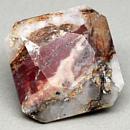|
|
||||||||||||||||
|
||||||||||||||||
|
||||||
|
|
|
|
Ganophyllite
|
|
| | |
| Discovered in 1890; IMA status: Valid (pre-IMA; Grandfathered) | ||
|
| ||
|
Chemistry |
|
|
| |
|
(K,Na,Ca)2Mn8(Si,Al)12(O,OH)32 • 8H2O | |
|
|
Hydrated Potassium Sodium Calcium Manganese Silicate Hydroxide |
|
Molecular Weight: |
1,514.20 gm |
|
Composition: |
Potassium |
3.87 % |
K |
4.67 % |
K2O |
|
|
Sodium |
0.76 % |
Na |
1.02 % |
Na2O |
|
|
Magnesium |
2.41 % |
Mg |
3.99 % |
MgO |
|
|
Manganese |
21.77 % |
Mn |
28.11 % |
MnO |
|
|
Aluminum |
5.88 % |
Al |
11.11 % |
Al2O3 |
|
|
Silicon |
16.69 % |
Si |
35.71 % |
SiO2 |
|
|
Hydrogen |
1.60 % |
H |
14.28 % |
H2O |
|
|
Oxygen |
47.02 % |
O |
|
|
|
|
|
100.00 % |
|
98.89 % |
= TOTAL OXIDE |
|
|
|
||||
|
Classification |
|
|
| |
|
SILICATES (Germanates) | |
|
8/H.17-60 | |
|
|
9 : SILICATES (Germanates)
|
|
Related to: |
Ganophyllite Group. The potassium analogue of Eggletonite. |
|
Members of Group: |
Ganophyllite Group: Eggltonite, Ganophyllite, Tamaite |
|
Varieties: |
None |
|
Synonyms: |
ICSD 64788, PDF 21-359 |
|
|
|
|
Crystal Data |
|
|
|
|
|
Short to long prismatic crystals, to 2.5 cm, forming balls or rosettes; as six-sided micaceous flakes or fine-grained micaceous aggregates |
|
|
None |
|
|
|
|
|
Physical Properties |
|
|
|
|
|
Perfect micaceous on {001}; distinct on {100}, {010} |
|
|
Foliated |
|
|
Brittle |
|
|
4.0 - 4.5 |
|
|
2.77 - 2.84 (g/cm3) |
|
|
None |
|
|
Barely Detectable; GRapi = 55.45 (Gamma Ray American Petroleum Institute Units) |
|
|
|
|
|
Optical Properties |
|
|
|
|
|
Light brown, brownish yellow, cinnamon brown, pale pink |
|
|
Transparent to translucent |
|
|
Brilliant on cleavage surfaces |
|
|
1.537 - 1.613 Biaxial ( - ) |
|
|
0.076 |
|
|
Weak; r < v |
|
|
Dark to pale yellow-brown |
|
|
|
|
|
Occurances |
|
|
|
|
|
Geological Setting: |
In manganese-rich portions of metamorphosed Zn-Mn mineral deposits. |
|
Common Associations: |
Calcite, Rhodonite, Caryopilite, Barite, Lead, Garnet, Manganoan Biotite, Pyrophanite (Harstigen mine, Sweden); Rhodonite, Willemite, Bustamite, Axinite, Clinohedrite, Datolite, Roeblingite, Charlesite (Franklin, New Jersey, USA); Parsettensite, Caryopilite (Molinello mine, Italy). |
|
Common Impurities: |
Fe, Zn, Pb, Ca, Ba |
|
Type Locality: |
Harstigen Mine, Pajsberg, Persberg district, Filipstad, Värmland, Sweden |
|
Year Discovered: |
1890 |
|
View mineral photos: | |
|
|
|
|
More Information |
|
|
|
|
|
| |
|
|
|
|
Locations
for Ganophyllite: In
Sweden, from the Harstigen mine, near Persberg, and
at Långban, Väarmland; and in the Sjö
mine, near Grythyttan, Örebro. At the Benallt and
Nant mines, Rhiw, Lleyn Peninsula, Wales. From the Molinello
and Gambatesa manganese mines, near Chiavari, Val Graveglia,
Liguria, Italy. In the USA, in the Maple-Hovey deposits,
west of Bridgewater, Aroostook County, Maine, and at
Franklin, Sussex County, New Jersey. From Mont Saint-Hilaire,
Quebec, Canada. In the Ananai mine, Nagaoka, Kochi Prefecture;
the Noda-Tamagawa mine, Iwate Prefecture; the Kumahata
mine, Shiga Prefecture; and the Osu and Yonoyama mines,
Kita, Ehime Prefecture, Japan. From Broken Hill, New
South Wales, Australia. |
|
|
We
have not photographed our Ganophyllite
gems
yet. Please
check back soon. |
